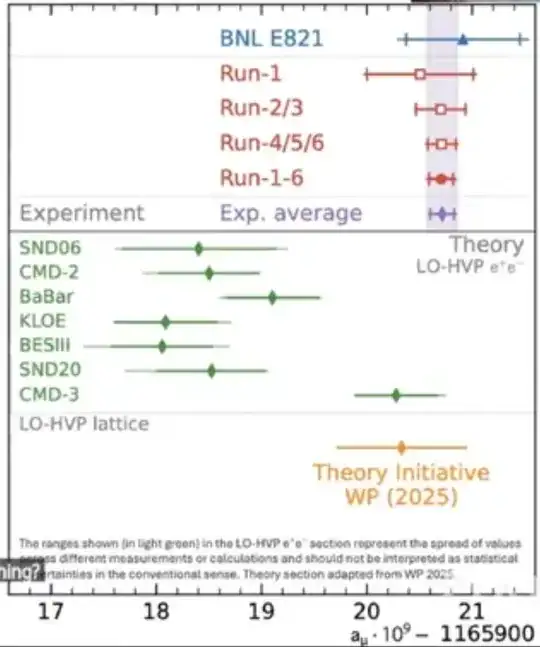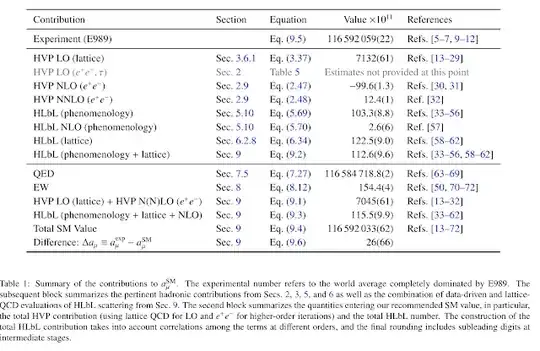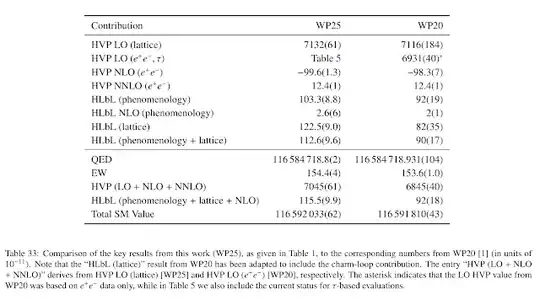This seems rather incredible that these two seemingly conflicting
announcements come on the same day.
The pre-print for the Nature paper by the BMW group was placed on arXiv in 2020 around the same time as the muon g-2 Theory Initiative paper (submitted on 8 Jun 2020 and last revised 13 Nov 2020, published here) that the Fermilab collaboration referenced in its announcement. The BMW pre-print was posted February 27, 2020, and last revised on August 18, 2020. (The 14-person BMW team is named after Budapest, Marseille and Wuppertal, the three European cities where most team members were originally based.) So, insiders weren't surprised.
Fermilab announced when its experimental results would be shared. Nature intentionally and strategically released the paper that had been in their offices awaiting publication for about eight months on the same day to maximize its impact. The theory presentation on Zoom this morning from Fermilab actually mentioned the BMW paper in passing although it didn't emphasize the point.
The BMW paper and the Theory Initiative paper use quite different methodologies to calculate the leading order Hadronic Vacuum Polarization (LO-HVP) contribution to the Standard Model muon g-2 calculation, which is the dominant source of theoretical uncertainty in the calculation. The BMW paper makes some refinements in the calculation that are very computation intensive (it took several hundred million "core hours" on seven sets of supercomputers to calculate) and is a straight up theory calculation (Quanta Magazine has a nice discussion of what this involved with a bit more depth). The Theory Initiative paper uses data on electron-positron annihilation products experimentally as a substitute for doing some key calculations that BMW does "on paper" (with BMW criticizing the Theory Initiative and others using similar methods for not transitioning the experimental data into the theoretical calculation in the manner that they think is correct).
The new Fermilab experimental results largely confirmed the previous Brookhaven measurement of muon g-2; the two experimental results were consistent at the 0.6 sigma level. The new Fermilab results moved slightly from the previous measurement in favor of the theoretically predicted values. The results were (all multiplied by a factor of 10-11):
| source |
result |
| Brookhaven's E821 (2006) |
116,592,089(63) |
| Combined Experimental Measurement |
116,592,061(41) |
| Fermilab (2021) |
116,592,040(54) |
| BMW Standard Model Prediction |
116,591,954(55) |
| Theory Initiative Standard Model Prediction |
116,591,810(43) |
| BMW - Theory Initiative |
144 |
(It is also worth noting that all of the experimental results and all of the theoretical predictions are all identical when rounded to the first six significant digits, i.e. at a parts per million level.)
Compared to the combined results used for the 4.2 sigma compared to the Theory Initiative paper, the BMW number is consistent with the combined experimental result at the 1.6 sigma level. The BMW paper claims 27% more uncertainty in its theoretical result than the Theory Initiative paper and the Theory Initiative result has been replicated (something much more difficult to do in the case of the much more computation resource intensive BMW calculation), which is part of the reasons that Fermilab decided to go with the Theory Initiative benchmark (another is that the Fermilab theory director is part of the Theory Initiative collaboration, while the BMW collaborators aren't affiliated with Fermilab).
A new pre-print making a more precise calculation of the hadronic light by light contribution to muon g-2 (reducing the relative error in that component of the calculation from 20% to 14%) was also strategically released on arXiv today. It adds 14.8 * 10-11 to the BMW prediction. Combined with the BMW prediction this is 158.8 * 10-11 more than the Theory Initiative Standard Model Prediction. So, including this result as well as the BMW prediction would further reduce the experiment-SM prediction discrepancy to 1.3 sigma (the two innovations do not overlap).
It will be interesting to see if the Lattice QCD/SM prediction theorists will be able to reach a consensus on this issue, which was a simmering behind the scenes controversy for months before this announcement. Multiple conferences on the muon g-2 calculation are planned for the next year (as the theory presentation from Fermilab this morning mentioned) and this disparity will be at the top of the agenda at all of them.
The stakes are pretty high. If the Theory Initiative is right, new physics beyond the Standard Model almost certainly exist and are right around the corner. If the BMW collaboration is correct, the prospect for new beyond the Standard Model High Energy Physics discoveries at experiments that are possible to conduct in our lifetimes is dismal.
An intermediate possibility is that neither calculation secures consensus support, but that the QCD community concludes, based upon the disparity between the legitimately calculated Theory Initiative result and the legitimately calculated BMW collaboration result, that both papers have grossly underestimated the amount of theoretical uncertainty present in their SM prediction calculations. This would leave us in the same limbo we've been in on muon g-2 for the last two decades.
If you are a visual leaner, you can read the comic strip explanation.
UPDATE
On June 3, 2025 the final Fermilab muon g-2 measurement including all six runs of the experiment was announced, with the paper announcing the result available here. Data taking alone took six years and it took several years to plan and set up the experiment. About 200 scientists were involved at some point from a wide array of scientific disciplines. A chart from the Fermilab YouTube presentation illustrates the progression of the various muon g-2 measurements and Standard Model predictions:

The new experimental result from Fermilab is The new experimental result from Fermilab Runs 1-6 combined is:
0.01165920705(148)
The new global average from Brookhaven and Fermilab combined is:
0.01165920715(145)
The uncertainty in the global average of the experimental measurements (which is 124 parts per billion) is about a quarter of the uncertainty in the latest 2025 White Paper Standard Model predicted value calculation (which is about 530 parts per billion).
A third independent direct measurement of aµ, which uses a different methodology, is the goal of the E34 experiment at J-PARC, which is likely to report its first result in the years 2027 or 2028.
A revised Standard Model prediction for muon g-2 was released a week earlier. It is R. Aliberti, et al., "The anomalous magnetic moment of the muon in the Standard Model: an update" arXiv:2505.21476 (May 27, 2025) (188 pages). This new prediction, which abandoned the data driven approach because the data relied upon had grown irreconcilable with each other, while the lattice QCD predictions were consistent, is:
0.01165920330(620)
(the final zeroes were added to give the same number of decimal places to the experimental measurement and the Standard Model prediction for visual clarity in the SE interface format)
The 2025 Theory Initiative White Paper explains that:
The most important development since WP20 is the change in the
estimate of the leading-order hadronic-vacuum-polarization (LO HVP)
contribution. A new measurement of the e+e−→π+π− cross section by
CMD-3 has increased the tensions among data-driven dispersive
evaluations of the LO HVP contribution to a level that makes it
impossible to combine the results in a meaningful way. At the same
time, the attainable precision of lattice-QCD calculations has
increased substantially and allows for a consolidated lattice-QCD
average of the LO HVP contribution with a precision of about 0.9%.
The basis for the new Theory Initiative paper is explained in a summary chart:

Another chart summarized what changed between the 2020 White Paper and the 2025 White Paper:

The world average value of muon g-2 (as of June 3, 2025) minus the 2025 White Paper SM prediction is (385 ± 637) × 10−12. This a difference of about 0.6 sigma (i.e. 0.6 standard deviations between the experimental value and the Standard Model prediction). This is a very strong global confirmation of the Standard Model of Particle Physics at low to moderate energies. This means that no new physics are expected at energies that could influence muon g-2 in amounts significantly greater than the uncertainty in this result.
Most likely, the discrepancy is mostly due to the leading order hadronic vacuum polarization (LO-HVP) calculation in the Standard Model prediction being about 0.5% low in a calculation with a ± 0.9% uncertainty.
The uncertainty in the LO-HVP calculation using Lattice QCD methods will be hard to reduce in the near future, because the uncertainty in this calculation is on the same order of magnitude as the uncertainties in the fundamental physical constants, like the strong force coupling constant and the light quark masses, that are inputs into the calculation.
The 2025 Theory Initiative paper states that they believe that they can greatly reduce the LO-HVP uncertainty to something comparable to the experimental measurement's uncertainty with a return to data driven approaches, and can accomplish this within a few years. But, in my humble opinion, this is wishful thinking.


